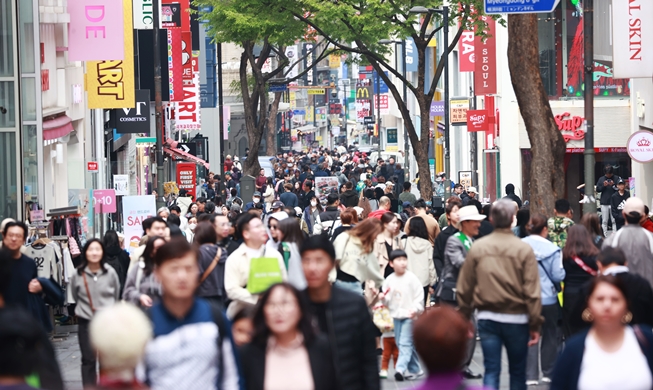-
 Korea.net's 24-hour YouTube channel
Korea.net's 24-hour YouTube channel- NEWS FOCUS
- ABOUT KOREA
- EVENTS
- RESOURCES
- GOVERNMENT
- ABOUT US
- 한국어
- English
- 日本語
- 中文
- العربية
- Español
- Français
- Deutsch
- Pусский
- Tiếng Việt
- Indonesian
The Mask Dances of the Five Clowns, the Ogwangdae
-The Mask Dances of the Five Clowns From Gasan
-The Mask Dances of the Five Clowns From Tongyeong
-The Mask Dances of the Five Clowns From Goseong
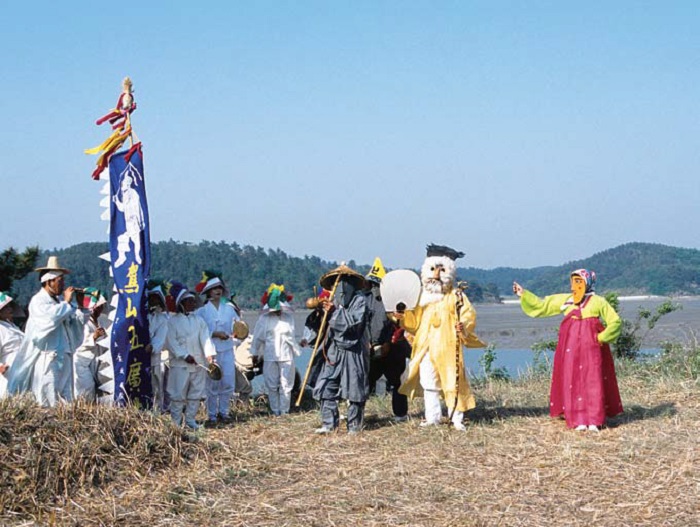
A scene from the old monk episode of the mask dances of the five clowns from Gasan.
The mask dances of the five clowns is a series of traditions that have been handed down in Gyeongsang Province, in the southeastern corner of Korea. The mask dances of the five clowns have been transmitted on the west side of the Nakdong River, while other traditions have been handed down on the east.
Both styles of mask dance are believed to have originated in the riverside area known as Chogye Bammari, currently located in the region of Hapcheon, South Gyeongsang Province. Roughly one hundred years ago, in the marketplace of Bammari, an itinerant professional entertainment troupe, known as the Daegwangdaepae, performed mask dances as part of their performances. This element of the troupe’s dance was handed down on both sides of the Nakdong River, creating the twin regional forms of mask dance: ogwangdae and yaryu.
The mask dances of the five clowns, or ogwangdae, refers to a mask dance which is either performed by five clowns or consists of five chapters. Today, the mask dances of the five clowns from the regions of Tongyeong and Goseong are comprised of five chapters. The mask dances of the five clowns from the Gasan region consists of six chapters, but features five characters in each chapter, including the five directional gods in the first chapter, five lepers in the third chapter and five shamans in the final chapter.
The mask dances of the five clowns from Gasan include distinct characteristics. The first chapter begins with a ritual dance for exorcism, the Dance of the Five Gods of the Five Directions, called a Obangsinjangmu. This is not found in the other types of five-clown mask dances.
Another unique characteristic is that the old nobleman dies in the episode of the old couple. The death of a male character is rare in other types of mask dance, where the old woman character, or the wife, comes into conflict with her husband’s mistress and then dies of a broken heart. The mask dances from Gasan portray a woman defying her patriarchal husband by insisting upon her rights.
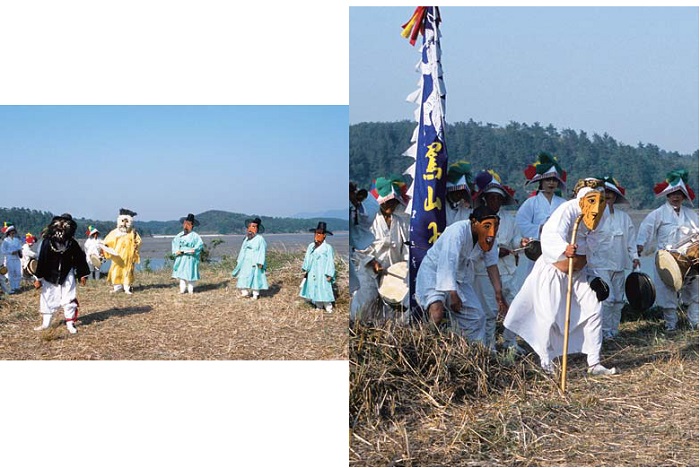
The nobleman scene from the five-clown mask dances of Gasan. (left) The old couple scene from the five-clown mask dances of Gasan.
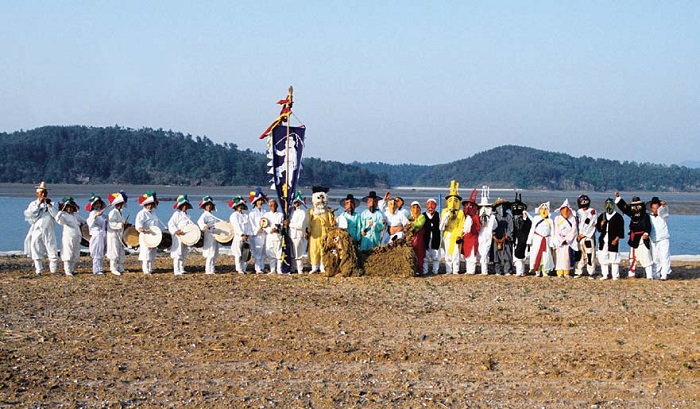
The clowns and musicians prepare for the five-clown mask dances from Gasan.
The five clown mask dances from Tongyeong do not include the ritual dance for exorcism or the criticism of apostate monks. Instead, it levels much more severe criticism at the nobility than do other mask dances of Korea.
The first chapter depicts a nobleman as a pathetic leper and the second chapter pokes fun at the nobility by presenting a variety of noblemen suffering diseases, such as the eldest nobleman, the second nobleman, the red-and-white-faced nobleman, the faltering nobleman, the black-faced nobleman and the nobleman with the pockmarked face. The third chapter presents a nobleman threatened with death by the legendary beast Yeongno that must devour one hundred noblemen before returning to heaven and turning into a dragon.
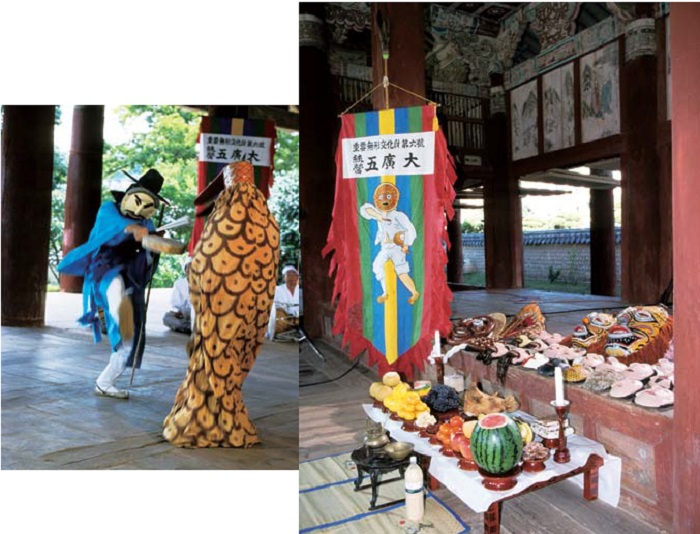
A fight scene between the beast Yeongno and a nobleman from the five-clown mask dances of Tongyeong. (left) A table for ceremonial offerings is prepared before the performance of Tongyeong's five-clown mask dance.
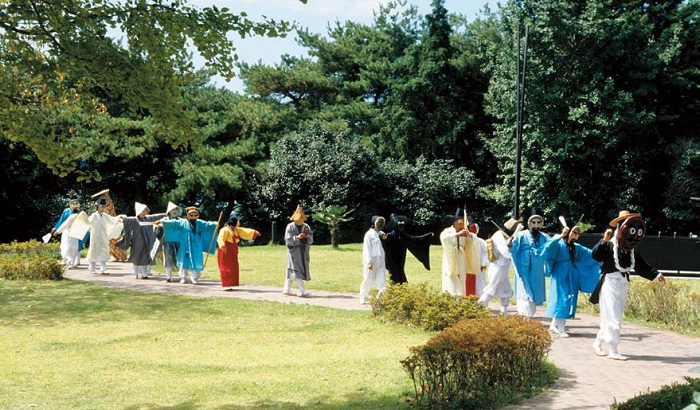
A pre-show parade takes place before a performance of the Tongyeong five-clown mask dance.
In contrast, the five clown mask dances from Goseong level a softer criticism at the nobility.
Although a leper appears in the opening chapter, he does not simply sit and bewail his lot. This leper makes up his mind to begin a new life while cheerfully dancing with a small hand drum. Moreover, the fourth chapter presents a nobleman and the beat Yeongno dancing together to make up with one another. This kind of reconciliation is closely related with the social conditions at the end of Joseon times (1392-1910). Due to repeated invasions, it was urgently required for the Joseon people to unite rather than remaining internally divided. The changing perceptions of pre-modern society were reflected in this mask dance performance.
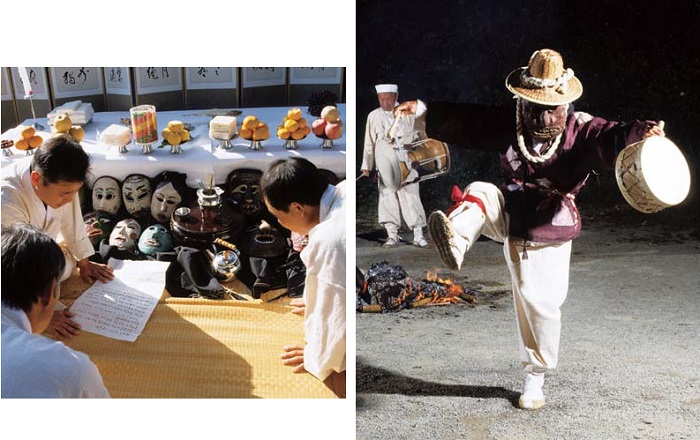
A written prayer is read to announce the beginning of a mask dance performance. (left) The leper's drum dance from the five-clown mask dances of Goseong.

Scenes from the five-clown mask dances of Goseong. The nobleman and the servant dance together.

A scene from the five-clown mask dances of Goseong. The bibi ridicules the nobleman. (left) The monk dance from the five-clown mask dances of Goseong.
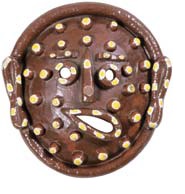
The leper mask from the five-clown mask dances of Tongyeong.
The five-clown mask dances from Tongyeong use thirty-one masks for their performances, including a leper, the red-and-white-faced nobleman, the faltering nobleman, the black-faced nobleman, the nobleman with the pockmarked face, a monk and a servant, along with a baby doll. The five-clown mask dances from Goseong use nineteen masks and a baby doll. Those from Gasan use thirty masks, including one for each of the five directional gods, one for the legendary Yeongno beast, one for a nobleman and one for the servant.
Overall, mask dances are characterized as rough, rustic and simple. They are also known for their distinctively odd features. It is clear how public grievances and resistance against the ruling classes are depicted in the masks.
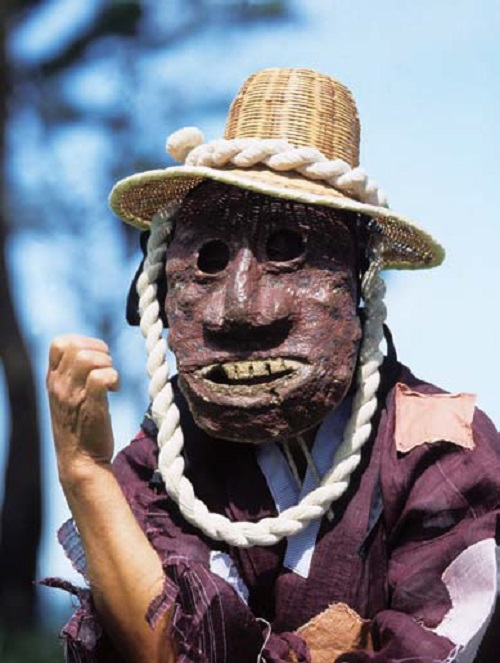
The leper mask of the five-clown mask dances from Goseong.
The leper mask
The leper, or mundungi, is a member of the aristocracy, suffering from leprosy in retribution for his ancestral sins. He bewails his lot, but tries to smother his resentment while performing a drum dance. The dance throws him into an ecstasy in which he finally finds a new life. The character appears in almost all the mask dance performances transmitted in Gyeongsang Province.
Masks of the five-clown mask dances from Gasan
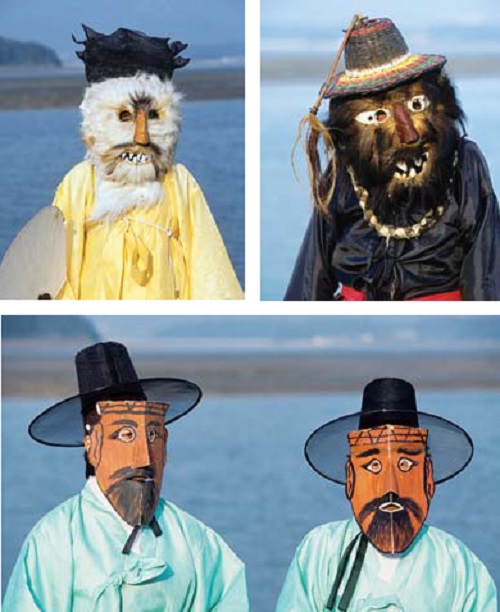
Clockwise from top left: The nobleman, the servant, the little noblemen
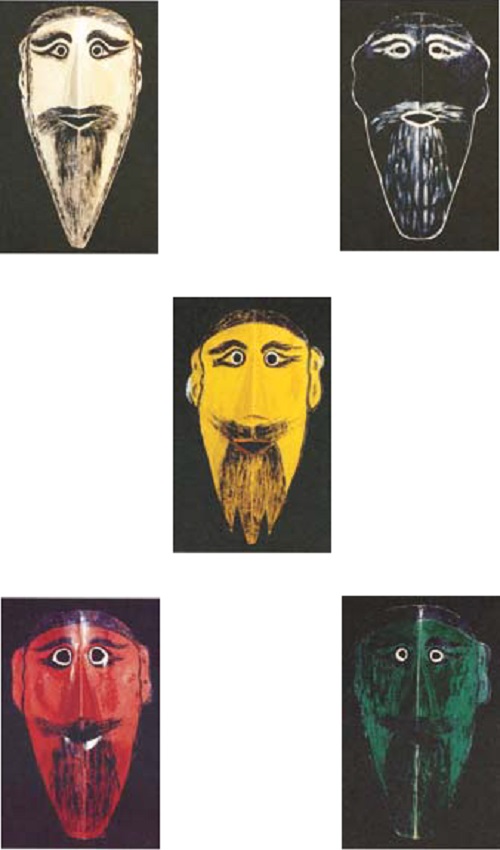
Various nobleman masks
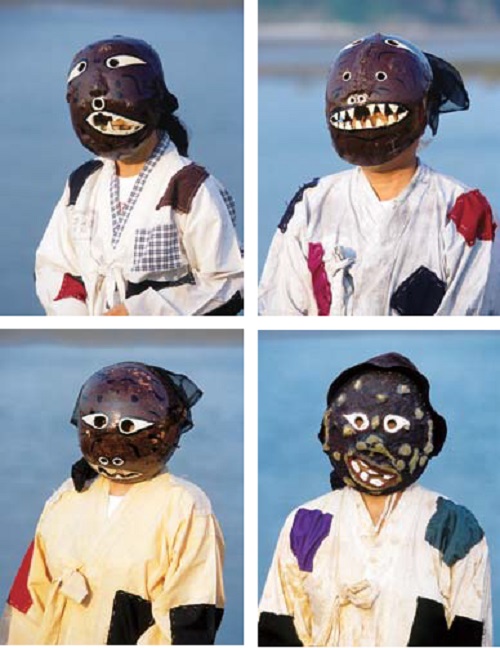
The leper
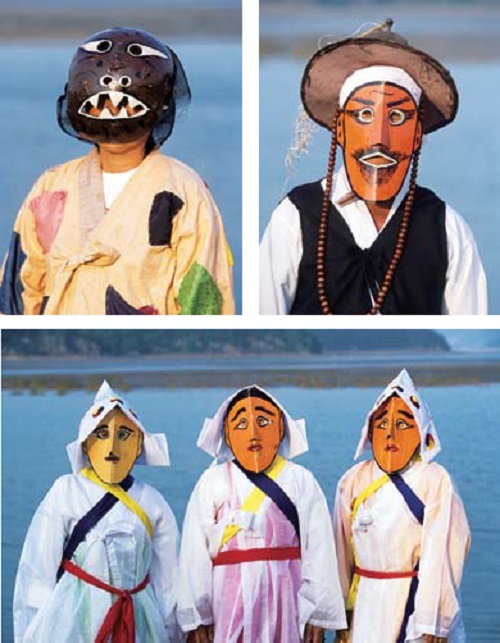
Clockwise from top left: The leper, the police constable, shamans
Masks from the five-clown mask dances of Gasan
The Korean names for the masks have been transliterated into English.
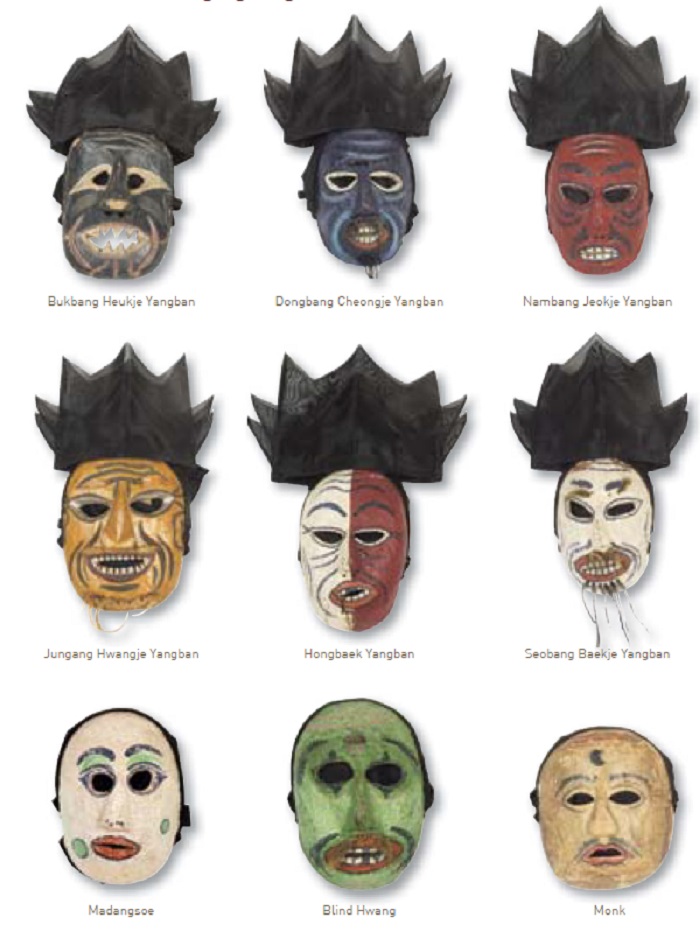
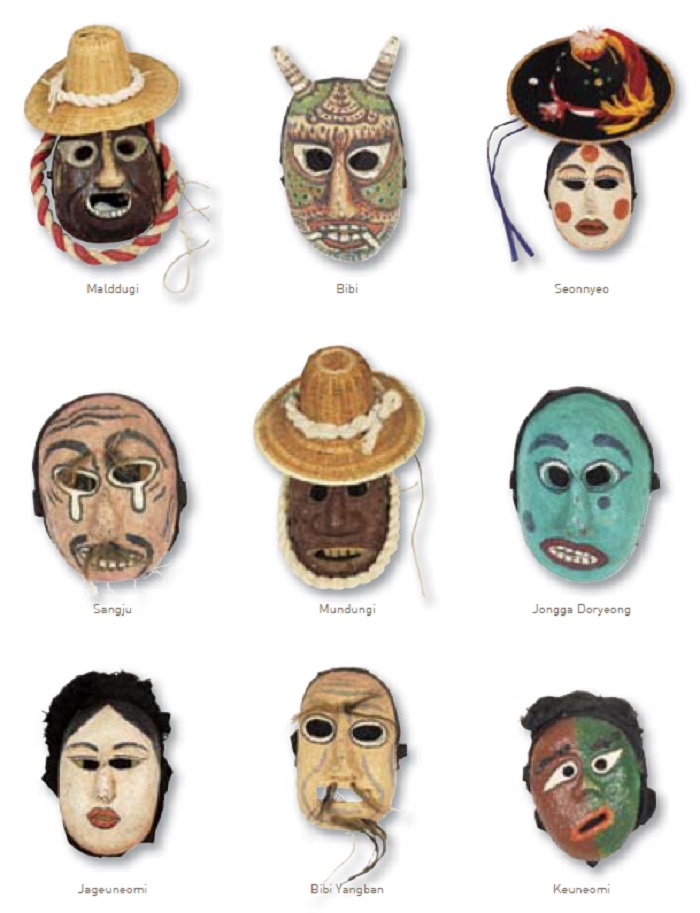
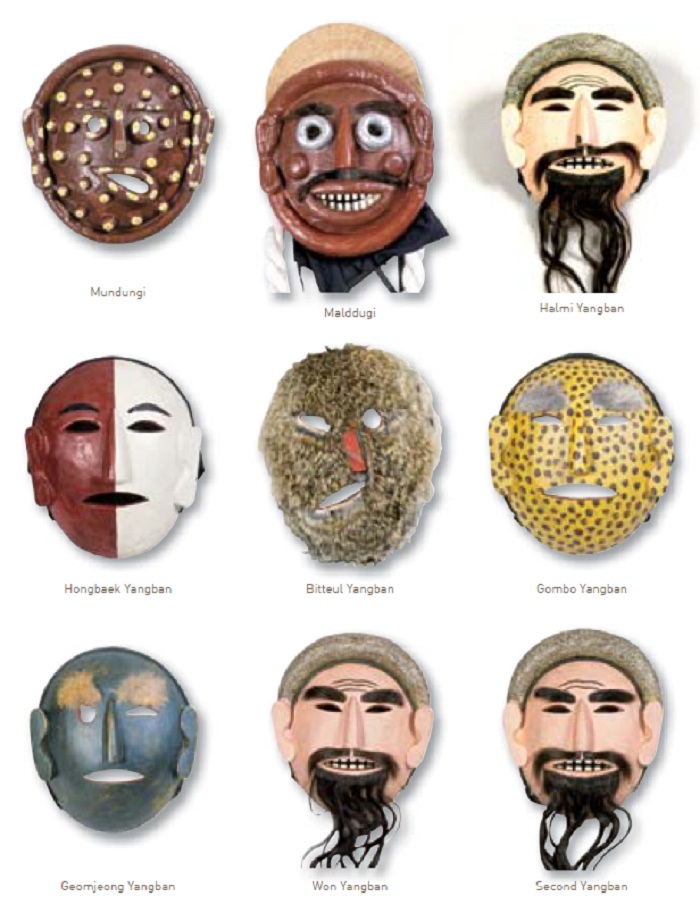
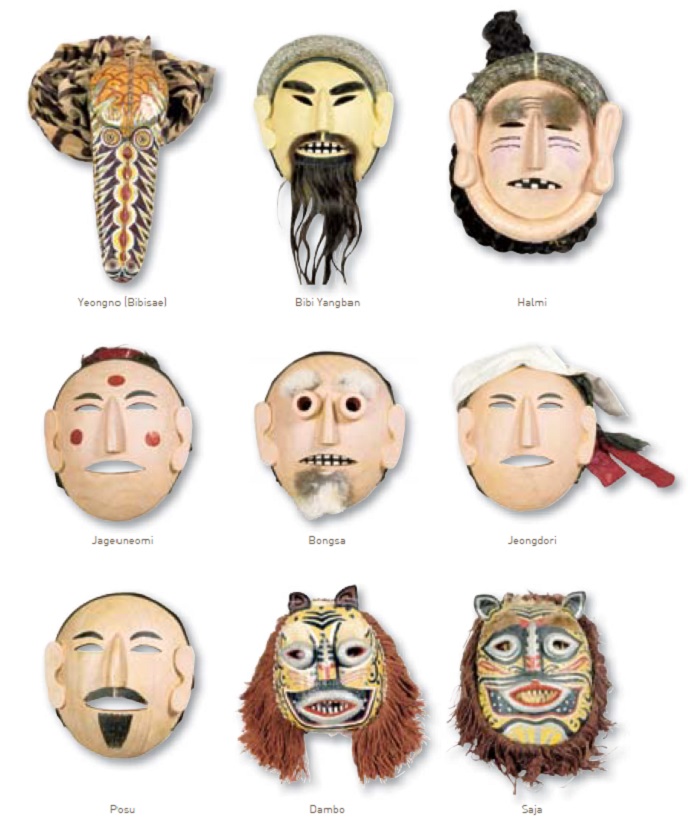
* This series of article has been made possible through the cooperation of the National Research Institute of Cultural Heritage. (Source: Intangible Cultural Heritage of Korea)
Most popular
- First hearing-impaired K-pop act hopes for 'barrier-free world'
- Expats could account for 7% of population in 20 years: report
- 'Mad Max' director impressed by 'cinema-literate' Korean viewers
- Show in Italy to present 'thought-filled' Korean craftworks
- Romanian presidential couple visits national cemetery




